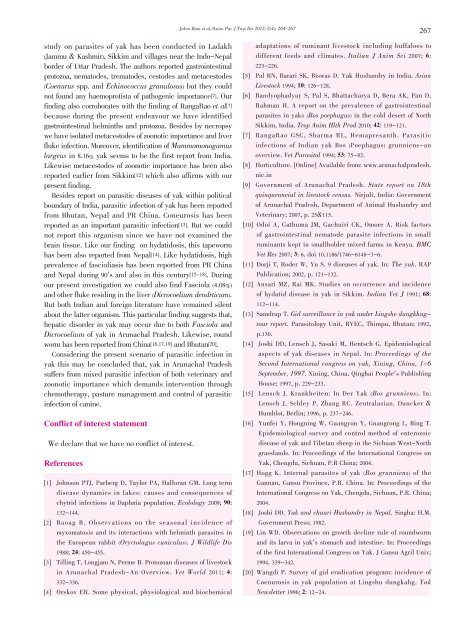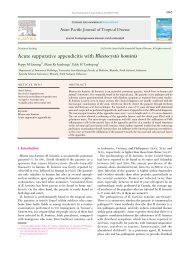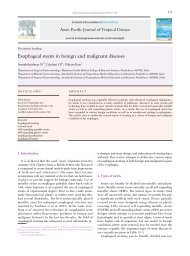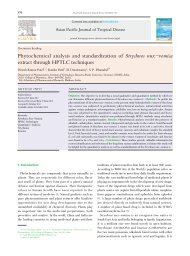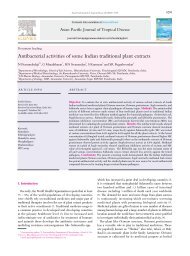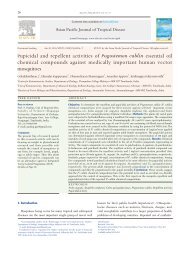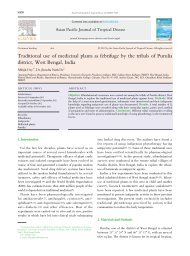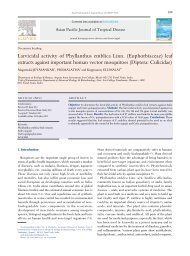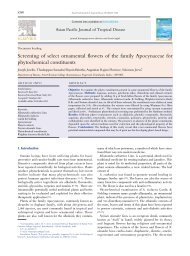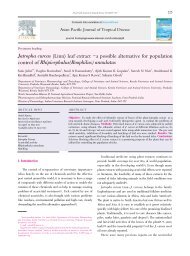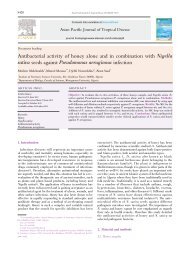Seasonal prevalence of parasitic infection of yaks in Arunachal ...
Seasonal prevalence of parasitic infection of yaks in Arunachal ...
Seasonal prevalence of parasitic infection of yaks in Arunachal ...
Create successful ePaper yourself
Turn your PDF publications into a flip-book with our unique Google optimized e-Paper software.
study on parasites <strong>of</strong> yak has been conducted <strong>in</strong> Ladakh<br />
(Jammu & Kashmir), Sikkim and villages near the Indo-Nepal<br />
border <strong>of</strong> Uttar Pradesh. The authors reported gastro<strong>in</strong>test<strong>in</strong>al<br />
protozoa, nematodes, trematodes, cestodes and metacestodes<br />
(Coenurus spp. and Ech<strong>in</strong>ococcus granulosus) but they could<br />
not found any haemoprotista <strong>of</strong> pathogenic importance[7]. Our<br />
f<strong>in</strong>d<strong>in</strong>g also corroborates with the f<strong>in</strong>d<strong>in</strong>g <strong>of</strong> RangaRao et al[7]<br />
because dur<strong>in</strong>g the present endeavour we have identified<br />
gastro<strong>in</strong>test<strong>in</strong>al helm<strong>in</strong>ths and protozoa. Besides by necropsy<br />
we have isolated metacestodes <strong>of</strong> zoonotic importance and liver<br />
fluke <strong><strong>in</strong>fection</strong>. Moreover, identification <strong>of</strong> Mammomonogamus<br />
largeus <strong>in</strong> 8.16% yak seems to be the first report from India.<br />
Likewise metacestodes <strong>of</strong> zoonotic importance has been also<br />
reported earlier from Sikkim[12] which also affirms with our<br />
present f<strong>in</strong>d<strong>in</strong>g.<br />
Besides report on <strong>parasitic</strong> diseases <strong>of</strong> yak with<strong>in</strong> political<br />
boundary <strong>of</strong> India, <strong>parasitic</strong> <strong><strong>in</strong>fection</strong> <strong>of</strong> yak has been reported<br />
from Bhutan, Nepal and PR Ch<strong>in</strong>a. Coneurosis has been<br />
reported as an important <strong>parasitic</strong> <strong><strong>in</strong>fection</strong>[13]. But we could<br />
not report this organism s<strong>in</strong>ce we have not exam<strong>in</strong>ed the<br />
bra<strong>in</strong> tissue. Like our f<strong>in</strong>d<strong>in</strong>g on hydatidosis, this tapeworm<br />
has been also reported from Nepal[14]. Like hydatidosis, high<br />
<strong>prevalence</strong> <strong>of</strong> fascioliasis has been reported from PR Ch<strong>in</strong>a<br />
and Nepal dur<strong>in</strong>g 90’s and also <strong>in</strong> this century[15-18]. Dur<strong>in</strong>g<br />
our present <strong>in</strong>vestigation we could also f<strong>in</strong>d Fasciola (4.08%)<br />
and other fluke resid<strong>in</strong>g <strong>in</strong> the liver (Dicrocoelium dendrticum).<br />
But both Indian and foreign literature have rema<strong>in</strong>ed silent<br />
about the latter organism. This particular f<strong>in</strong>d<strong>in</strong>g suggests that,<br />
hepatic disorder <strong>in</strong> yak may occur due to both Fasciola and<br />
Dicrocoelium <strong>of</strong> yak <strong>in</strong> <strong>Arunachal</strong> Pradesh. Likewise, round<br />
worm has been reported from Ch<strong>in</strong>a[16,17,19] and Bhutan[20].<br />
Consider<strong>in</strong>g the present scenario <strong>of</strong> <strong>parasitic</strong> <strong><strong>in</strong>fection</strong> <strong>in</strong><br />
yak this may be concluded that, yak <strong>in</strong> <strong>Arunachal</strong> Pradesh<br />
suffers from mixed <strong>parasitic</strong> <strong><strong>in</strong>fection</strong> <strong>of</strong> both veter<strong>in</strong>ary and<br />
zoonotic importance which demands <strong>in</strong>tervention through<br />
chemotherapy, pasture management and control <strong>of</strong> <strong>parasitic</strong><br />
<strong><strong>in</strong>fection</strong> <strong>of</strong> can<strong>in</strong>e.<br />
Conflict <strong>of</strong> <strong>in</strong>terest statement<br />
We declare that we have no conflict <strong>of</strong> <strong>in</strong>terest.<br />
References<br />
[1] Johnson PTJ, Parberg D, Taylor PA, Halloran GM. Long term<br />
disease dynamics <strong>in</strong> lakes: causes and consequences <strong>of</strong><br />
chytrid <strong><strong>in</strong>fection</strong>s <strong>in</strong> Daphnia population. Ecolology 2009; 90:<br />
132-144.<br />
[2] Baoag B. Observations on the seasonal <strong>in</strong>cidence <strong>of</strong><br />
myxomatosis and its <strong>in</strong>teractions with helm<strong>in</strong>th parasites <strong>in</strong><br />
the European rabbit (Oryctolagus cuniculus). J Wildlife Dis<br />
1988; 24: 450-455.<br />
[3] Till<strong>in</strong>g T, Longjam N, Perme B. Protozoan diseases <strong>of</strong> livestock<br />
<strong>in</strong> <strong>Arunachal</strong> Pradesh-An Overview. Vet World 2011; 4:<br />
332-336.<br />
[4] Orskov ER. Some physical, physiological and biochemical<br />
Joken Bam et al./Asian Pac J Trop Dis 2012; 2(4): 264-267 267<br />
adaptations <strong>of</strong> rum<strong>in</strong>ant livestock <strong>in</strong>clud<strong>in</strong>g buffaloes to<br />
different feeds and climates. Italian J Anim Sci 2007; 6:<br />
223-226.<br />
[5] Pal RN, Barari SK, Biswas D. Yak Husbandry <strong>in</strong> India. Asian<br />
Livestock 1994; 10: 126-128.<br />
[6] Bandyophadyay S, Pal S, Bhattacharya D, Bera AK, Pan D,<br />
Rahman H. A report on the <strong>prevalence</strong> <strong>of</strong> gastro<strong>in</strong>test<strong>in</strong>al<br />
parasites <strong>in</strong> <strong>yaks</strong> (Bos poephagus) <strong>in</strong> the cold desert <strong>of</strong> North<br />
Sikkim, India. Trop Anim Hlth Prod 2010; 42: 119-121.<br />
[7] RangaRao GSC, Sharma RL, Hemapresanth. Parasitic<br />
<strong><strong>in</strong>fection</strong>s <strong>of</strong> Indian yak Bos (Poephagus) grunniens-an<br />
overview. Vet Parasitol 1994; 53: 75-82.<br />
[8] Horticulture. [Onl<strong>in</strong>e] Available from: www.arunachalpradesh.<br />
nic.<strong>in</strong><br />
[9] Government <strong>of</strong> <strong>Arunachal</strong> Pradesh. State report on 18th<br />
qu<strong>in</strong>quenneial <strong>in</strong> livestock census. Nirjuli, India: Government<br />
<strong>of</strong> <strong>Arunachal</strong> Pradesh, Department <strong>of</strong> Animal Husbandry and<br />
Veter<strong>in</strong>ary; 2007, p. 25&115.<br />
[10] Odoi A, Gathuma JM, Gachuiri CK, Omore A. Risk factors<br />
<strong>of</strong> gastro<strong>in</strong>test<strong>in</strong>al nematode parasite <strong><strong>in</strong>fection</strong>s <strong>in</strong> small<br />
rum<strong>in</strong>ants kept <strong>in</strong> smallholder mixed farms <strong>in</strong> Kenya. BMC<br />
Vet Res 2007; 3: 6. doi 10.1186/1746-6148-3-6.<br />
[11] Dorji T, Roder W, Yu S. 9 diseases <strong>of</strong> yak. In: The yak. RAP<br />
Publication; 2002, p. 121-132.<br />
[12] Ansari MZ, Rai MK. Studies on occurrence and <strong>in</strong>cidence<br />
<strong>of</strong> hydatid disease <strong>in</strong> yak <strong>in</strong> Sikkim. Indian Vet J 1991; 68:<br />
112-114.<br />
[13] Samdrup T. Gid surveillance <strong>in</strong> yak under L<strong>in</strong>gshe dungkhagtour<br />
report. Parasitology Unit, RVEC, Thimpu, Bhutan; 1992,<br />
p.130.<br />
[14] Joshi DD, Lensch J, Sasaki M, Hentsch G. Epidemiological<br />
aspects <strong>of</strong> yak diseases <strong>in</strong> Nepal. In: Proceed<strong>in</strong>gs <strong>of</strong> the<br />
Second International congress on yak, X<strong>in</strong><strong>in</strong>g, Ch<strong>in</strong>a, 1-6<br />
September, 1997. X<strong>in</strong><strong>in</strong>g, Ch<strong>in</strong>a, Q<strong>in</strong>ghai People’s Publish<strong>in</strong>g<br />
House; 1997, p. 229-233.<br />
[15] Lensch J. Krankheiten: In Der Yak (Bos grunniens). In:<br />
Lensch J, Schley P, Zhang RC. Zentralasian. Duncker &<br />
Humblot, Berl<strong>in</strong>; 1996, p. 237-246.<br />
[16] Yunfei Y, Hongn<strong>in</strong>g W, Guangyon Y, Guangrong L, B<strong>in</strong>g T.<br />
Epidemiological survey and control method <strong>of</strong> enterozoic<br />
disease <strong>of</strong> yak and Tibetan sheep <strong>in</strong> the Sichuan West-North<br />
grasslands. In: Proceed<strong>in</strong>gs <strong>of</strong> the International Congress on<br />
Yak, Chengdu, Sichuan, P.R Ch<strong>in</strong>a; 2004.<br />
[17] Hogg K. Internal parasites <strong>of</strong> yak (Bos grunniens) <strong>of</strong> the<br />
Gannan, Gansu Prov<strong>in</strong>ce, P.R. Ch<strong>in</strong>a. In: Proceed<strong>in</strong>gs <strong>of</strong> the<br />
International Congress on Yak, Chengdu, Sichuan, P.R. Ch<strong>in</strong>a;<br />
2004.<br />
[18] Joshi DD. Yak and chauri Husbandry <strong>in</strong> Nepal. S<strong>in</strong>gha: H.M.<br />
Government Press; 1982.<br />
[19] L<strong>in</strong> WD. Observations on growth decl<strong>in</strong>e rule <strong>of</strong> roundworm<br />
and its larva <strong>in</strong> yak’s stomach and <strong>in</strong>test<strong>in</strong>e. In: Proceed<strong>in</strong>gs<br />
<strong>of</strong> the first International Congress on Yak. J Gansu Agril Univ;<br />
1994. 339-342.<br />
[20] Wangdi P. Survey <strong>of</strong> gid eradication program: <strong>in</strong>cidence <strong>of</strong><br />
Coenurosis <strong>in</strong> yak population at L<strong>in</strong>gshu dungkahg. Yak<br />
Newsletter 1996; 2: 12-24.


